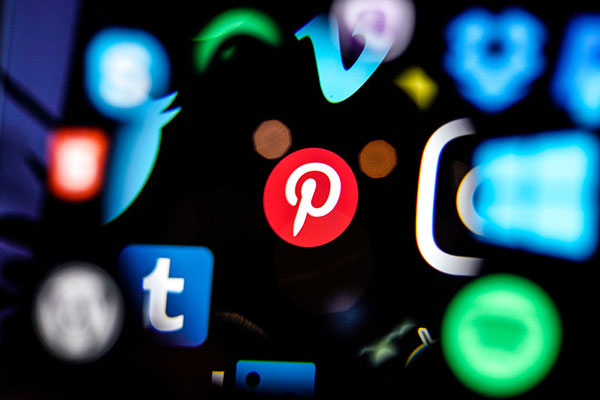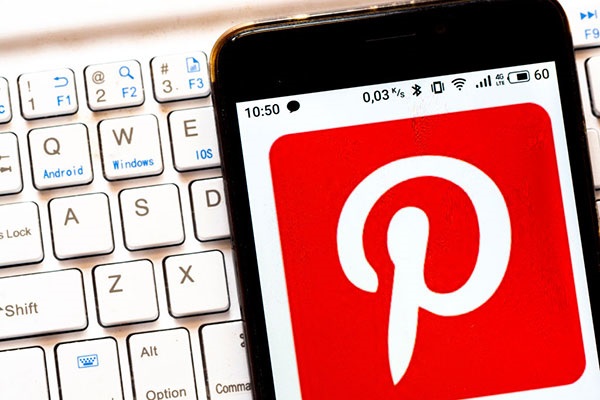Stockwatch: is Pinterest the best social media bet for investors?
The platform is more dynamic than Facebook or Instagram – but inflation lies in wait.
9th February 2021 13:04
by Edmond Jackson from interactive investor
The platform is more dynamic than Facebook or Instagram – but inflation lies in wait.

At the end of October last year, it struck me that the most dynamic US company reporting that week was Pinterest (NYSE:PINS).
This image-sharing and social media platform, founded 10 years ago, has become one of the top 10 largest social networks.
Its third-quarter 2020 results affirmed better dynamism than the likes of Facebook (NASDAQ:FB) or Instagram, and although the stock had jumped 27% to $62.50 (£45.41) this appeared to signal both a fundamental and stock technical break-out.
Third-quarter 2020 revenues had soared 58% and monthly active users by 37%, to 442 million - within which, international users had soared 46% to represent 78% of the total.
I thought this likely to set Pinterest apart from many other growth stocks.
Fourth-quarter 2020 shows strong growth continuing. The stock price has since risen 28% to more than $80, as traders seek to capitalise on the pandemic encouraging more time online – hence addiction to certain websites.
Yet the anticipation has been fair. Its latest fourth-quarter 2020 results show revenue growth accelerating, with 76% year-on-year growth in the fourth quarter to $706 million, or by 48% for 2020 as a whole (see table).
First-quarter 2021 revenue growth is guided in a low 70% range, year-on-year.
By comparison, Facebook and Alphabet (NASDAQ:GOOGL) have just reported advertising revenue up 22% and 31%, respectively.
Facebook’s monthly active users are up 14% versus 37% for Pinterest. Last October, I suggested Pinterest was shaping up as the prettiest face in social media – in the way Keynes compared stock-picking to guessing the judges’ selections in a beauty contest. While momentum reigns in the stock market, it is a powerful approach.
Management is focused on continuing to deliver “inspiring and shoppable content and helping advertisers realise the value and positivity of our platform”. This will define investment going forwards, within a general objective to scale the business.
Pinterest is well-capitalised to achieve this without shareholder dilution: its end-2020 balance sheet shows cash up 3% on the year to $669 million, but also $1.1 billion marketable securities, barely changed.
The company looks broadly self-financing in terms of growth: its annual cash flow statement shows net cash from operations near $29 million. However, the investing side diverges according to sales, maturities and purchases of marketable securities. The upshot is Pinterest needed no financial debt beyond employing $295 million lease liabilities.
$50 billion+ market value may be justified for the medium term
Manifestly, it borrows much from the future in terms of revenue excitement translating commensurately into earnings. It assumes, by this time Pinterest will not have been subverted by another media concept in vogue.
On a forward-looking basis, even assuming revenue trends towards $3 billion this year, it derives a hefty price/sales ratio in the high teens. Meanwhile, the company has just become net profitable to the tune of $208 million for the latest quarter after making an operating profit in the third quarter of 2019.
The intrigue is whether a rapidly rising margin – as you would expect when a fast-growing company tips into profit – tempers to a percentage that remains superior relative to other media-type companies.
Pinterest as an apple in advertisers’ eyes for its social draw, also enviable margins like tech giants Apple (NASDAQ:AAPL) and Microsoft (NASDAQ:MSFT) whose price-to-earnings ratio (PE) multiples have re-rated from the teens to mid-30s.
Pinterest has raised its earnings before interest, tax, depreciation and amortisation (EBITDA) margin from 1% in September 2019 to 19% in December, and up to 42% a year later. This is now exactly what Microsoft has reported in respect of its own fourth-quarter 2020 results.
- Tech trust up 40% over past year slips to unusually wide discount
- ii view: Facebook profit grows 52% but still cautious
I would be cautious how Microsoft’s annuity-type revenues, linked to annual subscriptions for cloud and software services, are likely more resilient in the long run than a social media site.
Media tends to be dynamic to attract popular interest, whereas companies are more likely to lock into a particular computing services package. If forced to choose between Pinterest and Microsoft on a 10-year view, I would opt for the latter.
Yet Pinterest is a fresher face in the growth-stock beauty contest and likely to report more exciting dynamics in the next two to three years. If its ‘operating’ margin is sustained over 40%, with its content capturing global user attention, dips in the stock will more likely be bought.

Yet judging inflation is as critical as company dynamics
Pinterest has a very hairy risk/reward profile given we are also approaching a crux for whether US inflation can reach the Federal Reserve’s 2% target (from 1.4% recently reported for 2020) or run away to 5% or even higher.
Growth companies are prized during the kind of low-inflation era the world has seen for several decades, given their relatively unique ability to achieve organic revenue growth and a decent margin.
But if we are at a long-term secular turning point for inflation – the effects of colossal fiscal/monetary stimulus debauching the value of money just when pent-up demand is released as vaccines temper the pandemic – then you should now lock in gains on highly rated growth stocks. Certainly, avoid them with fresh money.
As a measure of current macroeconomic excess: in the three months post-March 2020, monetary stimulus exceeded all that took place over nearly 30 years - from early 1980s recessions to the aftermath of the 2008 financial crisis.
On top of this, the Biden administration plans a $2 billion fiscal stimulus – cash handouts and the like – which is said by stock-market bulls to herald a repeat of the ‘Roaring Twenties’ after the First World War and Spanish Flu.
But this is liable to run into demand-pull inflation. Already in the corporate world, a basket of commodities has risen 40% in recent months. Crude oil has recovered all its fall during the pandemic as traders anticipate higher demand. Also, prices paid by manufacturers are at the highest level for a decade. The labour market is also tightening, which is a classic harbinger of inflation.
To date, investors who have feared inflation – especially as quantitative easing persisted after an initial crisis response to 2008 – have been on the wrong side of a major bull trade in growth stocks.
Prices have yet to broadly reach what central banks and governments seek to ‘inflate away’ excess levels of debt.
The nub is whether inflation consequences can be contained at 2% or so overall, amid egregious levels of fiscal/monetary stimulus, or take off towards 5% - i.e. interest rates would rise and growth stocks get hit.
Pinterest Inc - fourth-quarter 2020 highlights
| Three months ended 31 Dec | Year ended 31 Dec | ||||||
|---|---|---|---|---|---|---|---|
| US$ | US$ 000 | ||||||
| 2019 | 2020 | % change | 2019 | 2020 | % change | ||
| Revenue | 399,898 | 705,617 | 76% | 1,143 | 1,693 | 48% | |
| Net income/loss | -35,718 | 207,841 | 682% | -1,361 | -128 | 91% | |
| Adjusted EBITDA | 77,308 | 299,182 | 287% | 17 | 305 | 1726% | |
| Margin | 19% | 42% | 121% | 1% | 18% | ||
| Revenue breakdown | US$ | ||||||
| Global | 400 | 706 | 76% | 1,143 | 1,693 | 48% | |
| US | 350 | 582 | 67% | 1,026 | 1,425 | 39% | |
| International | 50 | 123 | 145% | 117 | 268 | 129% | |
| Monthly Active Users | |||||||
| Global | 335 | 459 | 37% | 335 | 459 | 37% | |
| US | 88 | 98 | 11% | 88 | 98 | 11% | |
| International | 247 | 361 | 46% | 247 | 361 | 46% | |
| Average revenue per user | |||||||
| Global | 1.22 | 1.57 | 29% | 3.81 | 4.26 | 12% | |
| US | 4.00 | 5.94 | 49% | 12.07 | 15.34 | 27% | |
| International | 0.21 | 0.35 | 67% | 0.54 | 0.88 | 62% |
Tempering my stance to ‘hold’
Pinterest will, I believe, be among the top-performing growth companies this year for revenue, and its profit will build impressively.
On inflation – hence the overall case for holding growth stocks – I am more cautious. Wise older economists such as Charles Goodhart argue that inflation is due to a secular increase on demographic factors anyway – the number of retirees and dependants increasing after several decades in which the world’s working age population steadily rose.
Labour is therefore empowered to negotiate higher wages in order to pay more taxes in support of an elderly demographic, which will boost inflation.
As an ex-member of the Bank of England’s monetary policy committee, he implies central banks are fuelling the potential inflationary fire with excess stimulus. However, a counter-argument is for taxes on wealthier older people, as governments look to those with the deepest pockets.
Time will tell, but Pinterest is a prime example of how I would currently avoid putting fresh money into growth stocks that are flavour of the month. Consider locking in at least some gains. Broadly: ‘hold’.
Edmond Jackson is a freelance contributor and not a direct employee of interactive investor.
These articles are provided for information purposes only. Occasionally, an opinion about whether to buy or sell a specific investment may be provided by third parties. The content is not intended to be a personal recommendation to buy or sell any financial instrument or product, or to adopt any investment strategy as it is not provided based on an assessment of your investing knowledge and experience, your financial situation or your investment objectives. The value of your investments, and the income derived from them, may go down as well as up. You may not get back all the money that you invest. The investments referred to in this article may not be suitable for all investors, and if in doubt, an investor should seek advice from a qualified investment adviser.
Full performance can be found on the company or index summary page on the interactive investor website. Simply click on the company's or index name highlighted in the article.
Disclosure
We use a combination of fundamental and technical analysis in forming our view as to the valuation and prospects of an investment. Where relevant we have set out those particular matters we think are important in the above article, but further detail can be found here.
Please note that our article on this investment should not be considered to be a regular publication.
Details of all recommendations issued by ii during the previous 12-month period can be found here.
ii adheres to a strict code of conduct. Contributors may hold shares or have other interests in companies included in these portfolios, which could create a conflict of interests. Contributors intending to write about any financial instruments in which they have an interest are required to disclose such interest to ii and in the article itself. ii will at all times consider whether such interest impairs the objectivity of the recommendation.
In addition, individuals involved in the production of investment articles are subject to a personal account dealing restriction, which prevents them from placing a transaction in the specified instrument(s) for a period before and for five working days after such publication. This is to avoid personal interests conflicting with the interests of the recipients of those investment articles.